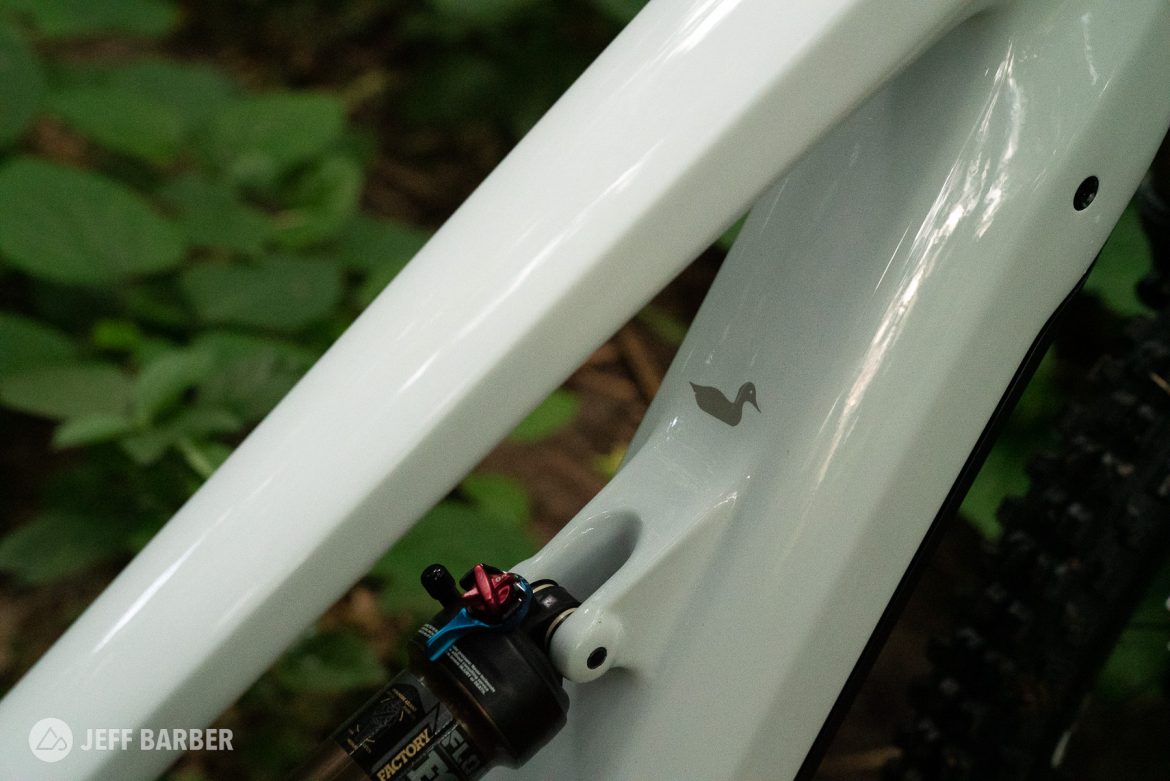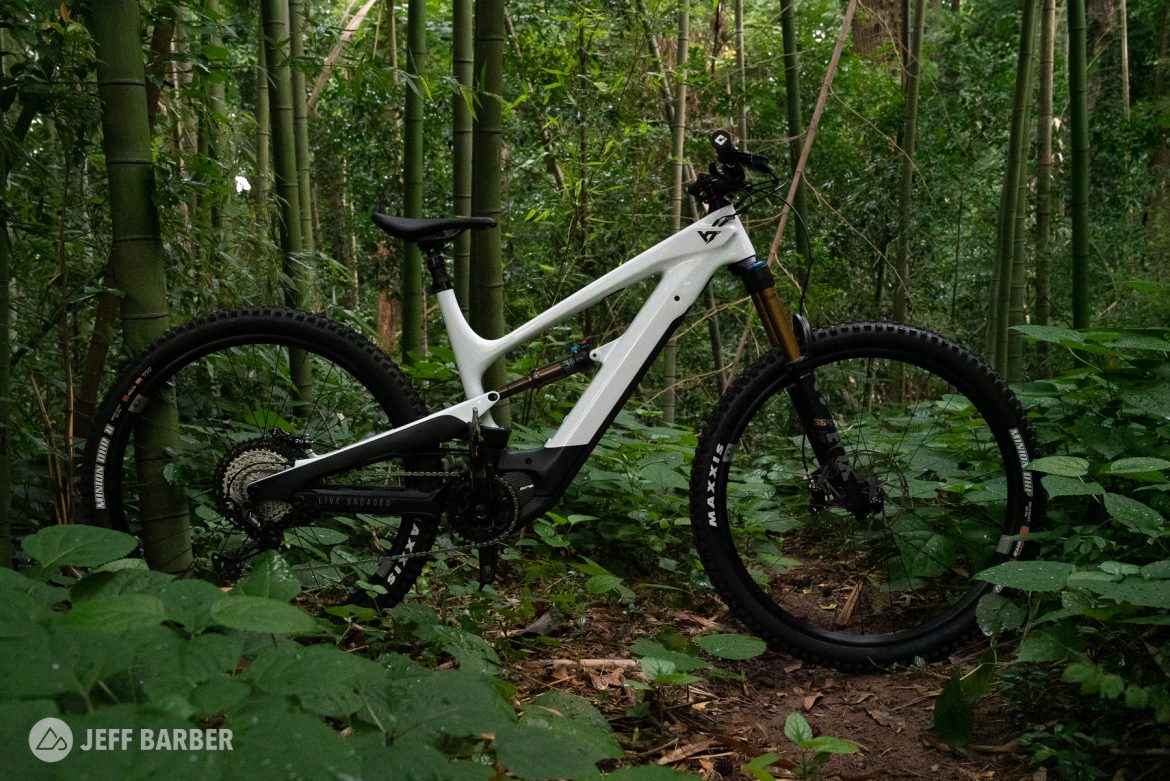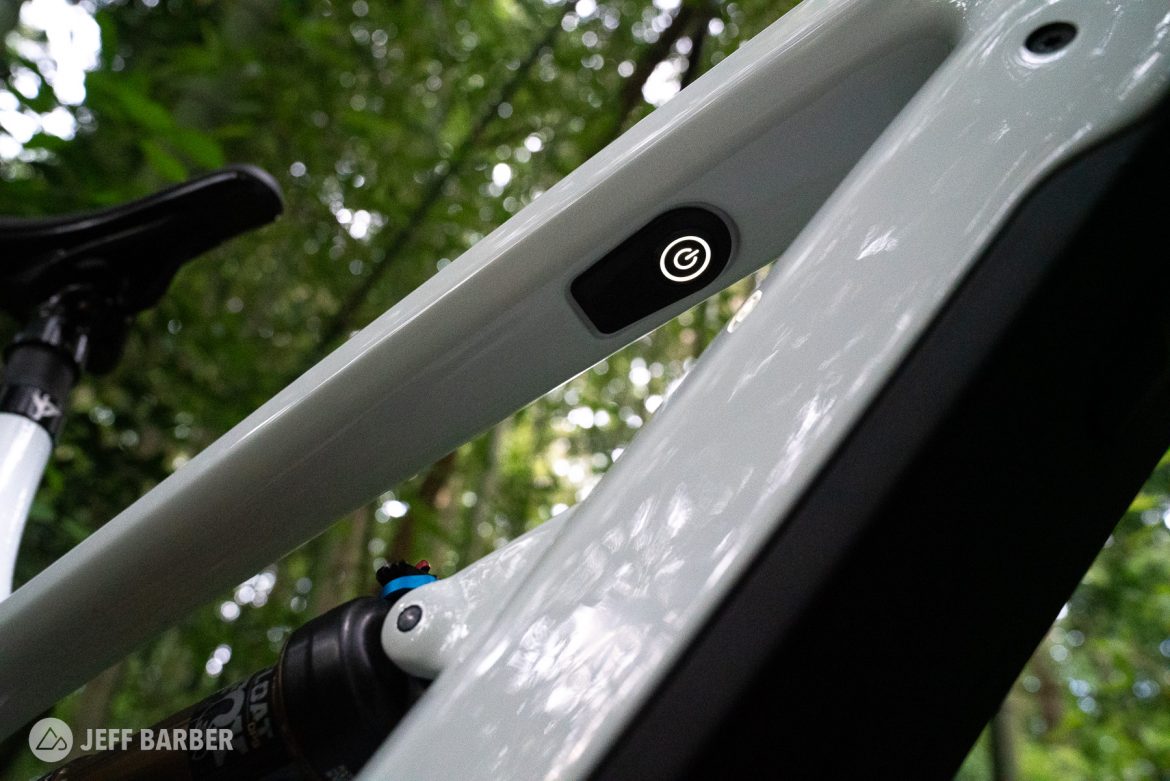If it looks like a duck, and quacks like a duck, it probably is a duck. At least, that’s how the saying goes.
Here’s another saying: If a bike has a motor, it’s a motorbike.

Yet the real world isn’t as black and white as either of those two phrases suggest. Sometimes a thing looks and quacks like a duck, but it’s actually a dog’s chew toy. Other times, a thing has a motor but it’s nothing like all the other motorized things.

At this point you probably realize I’m talking about the YT Decoy, an all-mountain, electric mountain bike (eMTB). I’ve been riding this duck for several weeks now and to say it defies easy categorization is an understatement. This is a bike that requires the rider to challenge themselves, to rethink the ride, and perhaps even blaze a new trail.

YT came out with the latest Decoy electric mountain bike models in May, including the 29er Core 4 build we have in for test. Here’s an early look at the bike, along with the geometry and key build specs ahead of testing.
YT Decoy frame


The Decoy 29 offers 150/145mm of suspension travel front and rear, respectively. All three builds utilize the same carbon frame, and the bike is available in two colorways: Trooper White (pictured) and Black Magic.

YT uses their Virtual 4 Link (V4L) suspension design on the Decoy, which is claimed to offer high anti-squat performance, in addition to a sensitive top end and “plenty of end-stroke progressivity.” As such I’ll be paying attention to both how well the bike descends and climbs to see if the suspension design lives up to its claims.
The frame integrates the 540Wh battery and Shimano EP8 motor for a seamless look. Naturally it’s also set up for internal cable, hose, and wire routing.

One unique frame feature is YT’s Fork Impact Protection zone, which provides a bit of extra insurance against fork-on-downtube contact. There’s also a flip chip that, in high mode, steepens the head angle by 0.5° and raises the bottom bracket for improved climbing performance. The size XL frame I’m testing does include mounts for a water bottle, but given the shock placement getting a bottle to fit will likely require a tight squeeze.
YT Decoy geometry

Overall the geometry on the YT Decoy 29 frame is about what one would expect for a trail / all-mountain bike in 2021. The 65.8° head tube angle (low) certainly isn’t the most slack, and it will be interesting to see how confidently the bike descends. At the other end of the equation, the 77° seat tube angle (77.5° in high) is suitably steep for a modern trail bike and should aid in climbing.
The reach numbers are middling, if a bit short, compared to the average trail bike, and the chainstays are on the mid to long end of the market. At 338mm in low mode, the bottom bracket (BB) height is spot on for the average trail bike in 2021.
The build

The Core 4 build I’ll be testing is the top end for Decoy 29 builds in the US, and retails for $7,499. Right off the bat buyers will note the Kashima-coated Fox Factory suspension components, including the Fox 36 e-bike specific 150mm fork.

A full Shimano XT 12-speed drivetrain comes with a stout 36T chainring mated to a 250W EP8 motor capable of delivering 85Nm of torque. YT is using the Shimano E7000 e-bike display along with their own custom 540Wh battery pack that can be charged either on or off the bike. The drivetrain adds an E13 chain guide for good measure.


Alloy Cranbrothers Synthesis wheels, with Industry Nine 101 hubs, sport 31.5mm internal rim widths are said to offer a tuned ride feel with a stiffer rear and more supple front. The wheels are shod with a 2.5-inch, EXO Maxxis Minion DHF in the front and a 2.4-inch, EXO+ Maxxis Minion DHR II in the rear.

At the helm, alloy 780mm-wide Renthal handlebars feature a 35mm clamping diameter, mated to a 50mm-long stem. There’s an Acros lock block headset to limit the front end turning radius and to protect the top and down tubes in the event of a crash. And in case the headset limiter fails, YT’s Fork Impact Protection zone is on backup duty.
Finally, the build includes a YT Postman dropper post, with the travel amount varying based on the frame size. My XL build offers 170mm of up-down.
All told, this size XL, YT Decoy 29 Core 4 bike weighs 50.24lbs. with pedals.
There’s no ‘easy button’
While the YT Decoy does have a power button, it’s definitely not the easy button riders might expect. For starters, this is a big bike designed for all-mountain riding. The e-specific 150mm Fox 36 Factory fork up front is an aggressive choice, soaking up big and repeated hits at high speed. At the other end, the bike delivers 145mm of rear travel. Once the heavy bike gets pointed downhill it picks up speed and momentum quickly, requiring a good bit of muscle and poise to control, particularly when it’s time to change direction.
Descending on the YT Decoy
YT has done a great job balancing the bike in terms of both the weight and the suspension design. With roughly the same amount of travel in the front and rear, neither felt like a limiter in terms of speed or performance. In fact, the rear end feels especially bottomless and resilient through fast, chunky sections punctuated by the occasional big hit. The bike’s “Virtual Four Link” seems to deliver on its promise of plenty of progressivity at the end stroke without giving up too much sensitivity at the other end of the spectrum.

For a 50+ pound bike, the YT Decoy also feels playful. It’s surprisingly easy to get into the air, even off small roots and rocks. The suspension design and tune, along with the e-specific shock and fork, give this heavy bike a much more traditional and familiar feel. I’m probably more sensitive than most riders to bike weight, and I found the Decoy isn’t strictly ground-bound by any means.
That being said, the weight is noticeable in a couple of different ways. On the positive end, the bike remains planted and corners like a dream, similar to Teslas and other electric cars with their low-slung weight. It holds a line and absolutely plows over and through anything in its way. In general, the weight seems to be well distributed on the bike front to back, however, I found the steering to feel a little plow-like. That is, transitioning from straight to turning, or vice versa tends to produce noticeable resistance.
There are a number of factors that can cause the front end of a mountain bike to feel like this: tire selection, geometry, headset operation, fork offset, and the like. I’m very familiar with the Maxxis Minion DHF tire so that isn’t it; the head tube angle is a reasonable ~66° (in fact, some will consider it too steep); and the headset seems to be working as it’s supposed to (not 100% stoked on it though, more on that later). I even went so far as to remove the battery pack for a test ride to see if taking weight off the front end improved the steering. As best I could tell, even 8.1 pounds lighter the bike felt almost exactly the same, which is actually pretty impressive. Clearly, there is another factor that gives the front end some resistance to changing direction, though I never nailed down what it is.
Climbing
I pushed the Decoy up some pretty steep climbs — literally — and like I said earlier, there’s no easy button. One of my test rides involved riding up a trail called Windy Gap that almost everyone either shuttles or rides up the long way around. It’s a shared-use trail that’s open to motorcycles, and from what I can tell few moto riders are even up to the climb. Even with the highest level of e-assist, I needed to walk a few parts, and according to my Garmin, my heart rate spiked as high as 192bpm along the way. Like other bikes equipped with a Shimano EP8 electric drivetrain, the Decoy has a walk mode to help push the bike up the steepest bits. In theory, it’s a helpful feature, but I found the rear wheel often lost traction without the weight of a rider on board, and the pre-programmed walk speed is a bit too slow for my anxious, long-legged hiking pace.
On steep, loose climbs I found very little rear-wheel slip when seated on the bike. The Maxxis Minion DHR II is a great rear tire and the Shimano EP8 motor is super sensitive and, dare I say intelligent when it comes to applying the right amount of torque at the right time. I keep saying the bike feels balanced, and that’s true for climbing as well. However, there comes a point when the trail is just so steep that the front end is going to lift and wander, and I definitely experienced that with the Decoy at times. I can’t really fault the geometry or design; if anything I learned that I need to adjust my riding style to lean farther forward into steep climbs and allow the motor to do its work. The ~77° seat tube angle is certainly climb-friendly, though let’s be honest: the motor is even more so.

When pedaling I experienced a bit of heel rub on the drive side chain stay protector (not the stay itself). Longer-term I would replace the rubberized protector with something less bulky and I suspect that would eliminate the issue.
In addition to big mountain riding, I also tested the YT Decoy on more technical local trails. To be honest, the bike just isn’t a great choice for that style of riding. While the motor is incredibly responsive, pedal stroke timing can get tricky, and a sudden jolt of battery-powered forward motion isn’t always what’s needed. The heavy overall weight means finesse moves take a good bit more strength, and the suspension can feel somewhat vague for slow-speed cornering. Then there’s the long 458mm chain stay length that makes sharp switchbacks challenging. Bottom line: The Decoy is best suited for riding big, fast trails with extended climbs and descents.
A wolf in sheep’s clothing
For the most part the YT Decoy looks like a traditional mountain bike. The battery and motor blend into the frame well, and while the down tube is noticeably thicker than most bikes, I suppose it could possibly be mistaken for an oversized stash box.
YT also sneakily placed the bike’s glowing power button on the underside of the top tube. Still, the bike beeps when you turn it on, there’s a backlit display for the battery life mounted at the bars, and there’s no mistaking the motor’s electric whine when powering up a climb.
I decided to see how long it would take folks on my usual night ride to figure out that I was riding an e-bike. Somewhat to my surprise, the bike didn’t fool anyone for long. And this was on a night ride, in the dark. As it turns out, nobody is mistaking this Decoy for a duck. It’s more like a wolf bounding up and down the trail at higher speeds than expected.


Design and durability
The Decoy battery is easy to remove for charging, or owners can leave the battery in place if there’s an outlet in their bike storage spot. The two bolts that secure the battery are quick to unscrew, and as a bonus the bike’s internal cables and hoses run beneath the battery for easy future maintenance. One annoyance is that it’s tough to get the rubber plug covering the charging port on the battery to sit flush, almost as if it’s a bit too big to fit the hole. With the port located on the underside of the down tube, I do worry about water or mud getting to the connector without a secure, water tight fit.
The battery cover itself seems to be very robust. I shuddered many times hearing hard rock strikes against the plate during my bigger rides, but upon inspection found little to no damage.

The Crankbrothers Synthesis wheels on this build are noteworthy as well. The rear wheel is designed to be stiffer and burlier than the front, which is an excellent call given the weight of the bike, and its intentions as an all-mountain shredder. I can’t say that the front and rear wheels feel all that different, but I also don’t doubt that they are different, and do make a difference in terms of durability and performance.
Let’s talk a bit about range anxiety. The Decoy comes with a 540wh battery, which is almost 100wh smaller than the Canyon Spectral:ON I tested earlier this year. On one test ride I climbed about 5,000ft over 20 miles with more than three hours of ride time, and ended the ride with about a quarter “tank” of juice left. On another ride, 18 miles long with about 1,600 of climbing, I mostly kept the assist mode set at ‘eco’ and was left with about three quarters of a full charge. Of course there are many factors that influence battery life and range, so your mileage will vary. I felt a lot more range anxiety about my electric car making it up to the mountains and back on a single charge than the Decoy running out of juice mid ride. At least the Decoy has pedals so I figure the bike will never truly leave me stuck.
Having a big battery paired with a highly capable and flat-out fun bike opens up a lot of possibilities like riding Windy Gap from bottom to top, and then doing it again in the same day. For really dedicated riders, a second battery opens up the possibility for even more runs, at least until the body gives up. I decided to ride trails I had avoided previously because the effort to ride them always seemed to outweigh the potential reward. With the Decoy, the calculus definitely changes.

One issue that’s likely not specific to this build is the placement of the e-bike assist controls. On many occasions I accidentally bumped the controls when reaching for the dropper lever, and there isn’t an obvious solution to improving the control layout. Similarly the Renthal Fatbar with its 35mm clamping surface diameter, 30mm rise, 7° back sweep, and 5° up sweep doesn’t leave much real estate for mounting a GPS, let alone a headlight, GPS, and a bell. The 780mm width generally feels comfortable and appropriate, though in this case I actually might prefer 800mm just to get a little extra room for cockpit accessories.
The size extra large bike I tested ships with a YT Postman dropper that offers 170mm of travel. The post works great, but as always I’d really appreciate even more travel. I don’t think 200mm is asking too much, especially on such a large frame.
Another cockpit nit I have to pick is the Acros block lock headset that limits the bike’s turning radius. I quickly bumped up against the limits in really tight switchbacks where rear wheel hops weren’t a great option either due to the bike’s weight. Like I said though, this bike isn’t really designed for low-speed, technical trails anyway so it’s truly a lice-egg-sized issue. If this were my bike, and I was planning to ride it everywhere, I might consider swapping for a normal, full-radius stem. YT already includes a bit of fork impact protection in the battery/down tube area so any accidental knocks shouldn’t be catastrophic.
Conclusion
The YT Decoy is a badass bike that inspired me to try riding harder, and progress my skills further, than ever before. At the same time, I personally couldn’t see myself owning this as my only mountain bike. While it’s incredibly capable and a ten on the fun meter, it’s also clearly not the right tool for all of my rides. Still, my bike menagerie would definitely benefit from this duck.
The YT Decoy 29 Core 4 build as tested is priced at $7,499USD.
Party laps
- Incredibly capable suspension platform for riding fast and rough
- Thoughtfully designed and constructed
- Great component selection for the price
Pros and cons of the YT Decoy 29 mountain bike.
Dirt naps
- Not a great choice for slow speed, technical trails
- Steering feels plow-like
- Still looks and sounds like an e-bike
Show your Support
Become a Singletracks Pro Supporter today and enjoy benefits like ad-free browsing.
With your support we can provide free worldwide trail information and original content created by our team of independent journalists.





















9 Comments
Nov 25, 2021
Nov 26, 2021
The other issue I found is that it can be tough to get traction in walk mode when there's no body weight on the bike. But that's really only on the steepest/slipperiest spots.
Nov 26, 2021
Nov 25, 2021
Nov 25, 2021
Nov 24, 2021
Nov 24, 2021
Mar 27, 2022
Mar 28, 2022